Asbestosis
Background
Asbestosis is a chronic lung disease caused by inhalation of asbestos fibers. Exposure to these fibers can cause lung tissue scarring and shortness of breath. Asbestosis can develop many decades after exposure to asbestos.
Risk factors
-
- Asbestos fibres (all types) [1]
Construction workers, such as insulators, electricians, and plumbers are several occupations that have experienced high rates of this condition. Metal workers and platers and boilermakers are also at an increased risk of asbestosis.
Key Findings
The greatest risks of asbestosis were observed among workers employed in construction and some manufacturing industries.
Construction
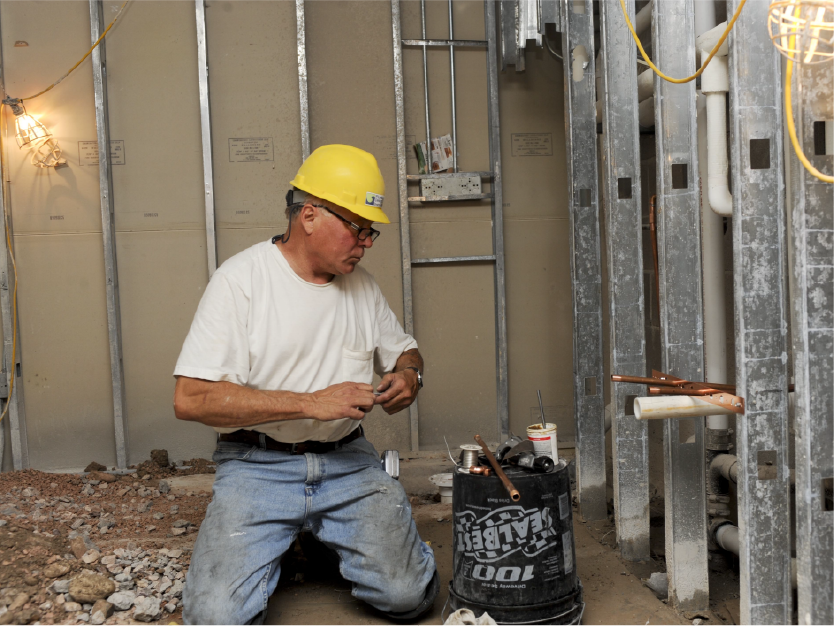 Asbestos-containing materials, particular insulation, were widely used in pre-1990 construction in Canada, and is still present in many older homes and buildings [2]. Insulators, plumbers, electricians, and other construction trades workers may frequently handle or work near asbestos-containing materials during building maintenance and renovation.
Asbestos-containing materials, particular insulation, were widely used in pre-1990 construction in Canada, and is still present in many older homes and buildings [2]. Insulators, plumbers, electricians, and other construction trades workers may frequently handle or work near asbestos-containing materials during building maintenance and renovation.
-
- Construction trades occupations: 3.50 times the risk
- Insulators: 25.4 times the risk
- Pipefitters and plumbers: 8.36 times the risk
- Plasterers and related: 5.38 times the risk
- Brick and stone masons and tile setters: 3.76 times the risk
- Electricians and repairers: 3.35 times the risk
- Carpenters and related: 2.05 times the risk
- Construction trades occupations: 3.50 times the risk
Non-metallic mineral products manufacturing
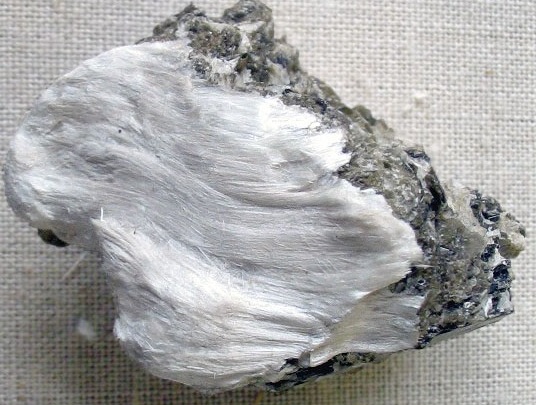 The non-metallic mineral products industry includes establishments engaged in manufacturing clay, cement and concrete, glass and glass products, and historically, asbestos and vermiculite products. The latter manufacturers are captured in the miscellaneous non-metallic mineral products industries, where the highest asbestosis risk was observed.
The non-metallic mineral products industry includes establishments engaged in manufacturing clay, cement and concrete, glass and glass products, and historically, asbestos and vermiculite products. The latter manufacturers are captured in the miscellaneous non-metallic mineral products industries, where the highest asbestosis risk was observed.
-
- Non-metallic mineral products industries: 2.14 times the risk
- Miscellaneous non-metallic mineral products: 7.56 times the risk
- Non-metallic mineral products industries: 2.14 times the risk
Metal-related industries and occupations
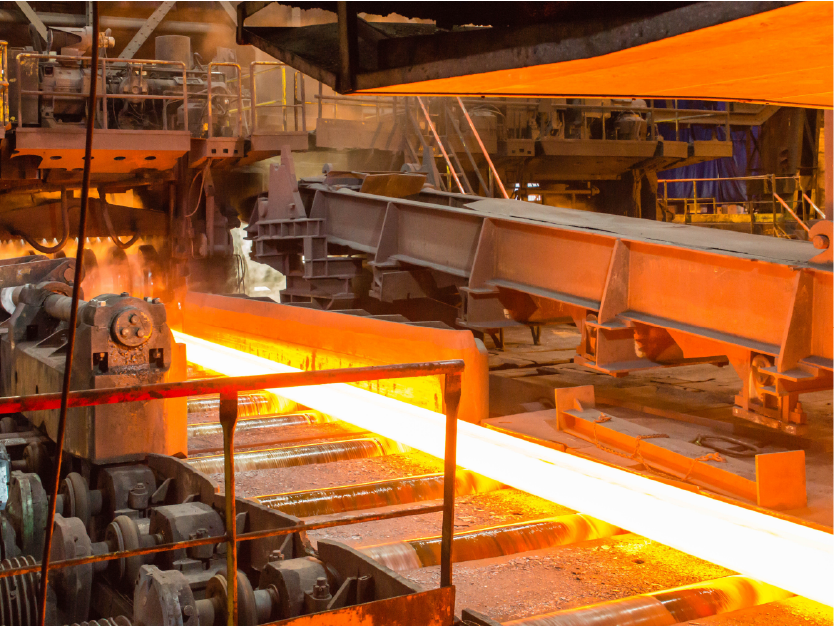 Asbestos was commonly used as an insulating material in some hot metalworking processes [3]. Primary metal industry workers may operate furnaces and other heating apparatuses insulated with asbestos. When these materials are disturbed or degrade, asbestos fibres can be released into the air.
Asbestos was commonly used as an insulating material in some hot metalworking processes [3]. Primary metal industry workers may operate furnaces and other heating apparatuses insulated with asbestos. When these materials are disturbed or degrade, asbestos fibres can be released into the air.
-
- Boilermakers, platers and structural metal workers: 9.96 times risk
- Sheet metal workers: 2.44 times the risk
- Primary metal industries: 2.34 times the risk
- Iron and steel mills: 2.77 times the risk
Mechanics and repairers except electrical
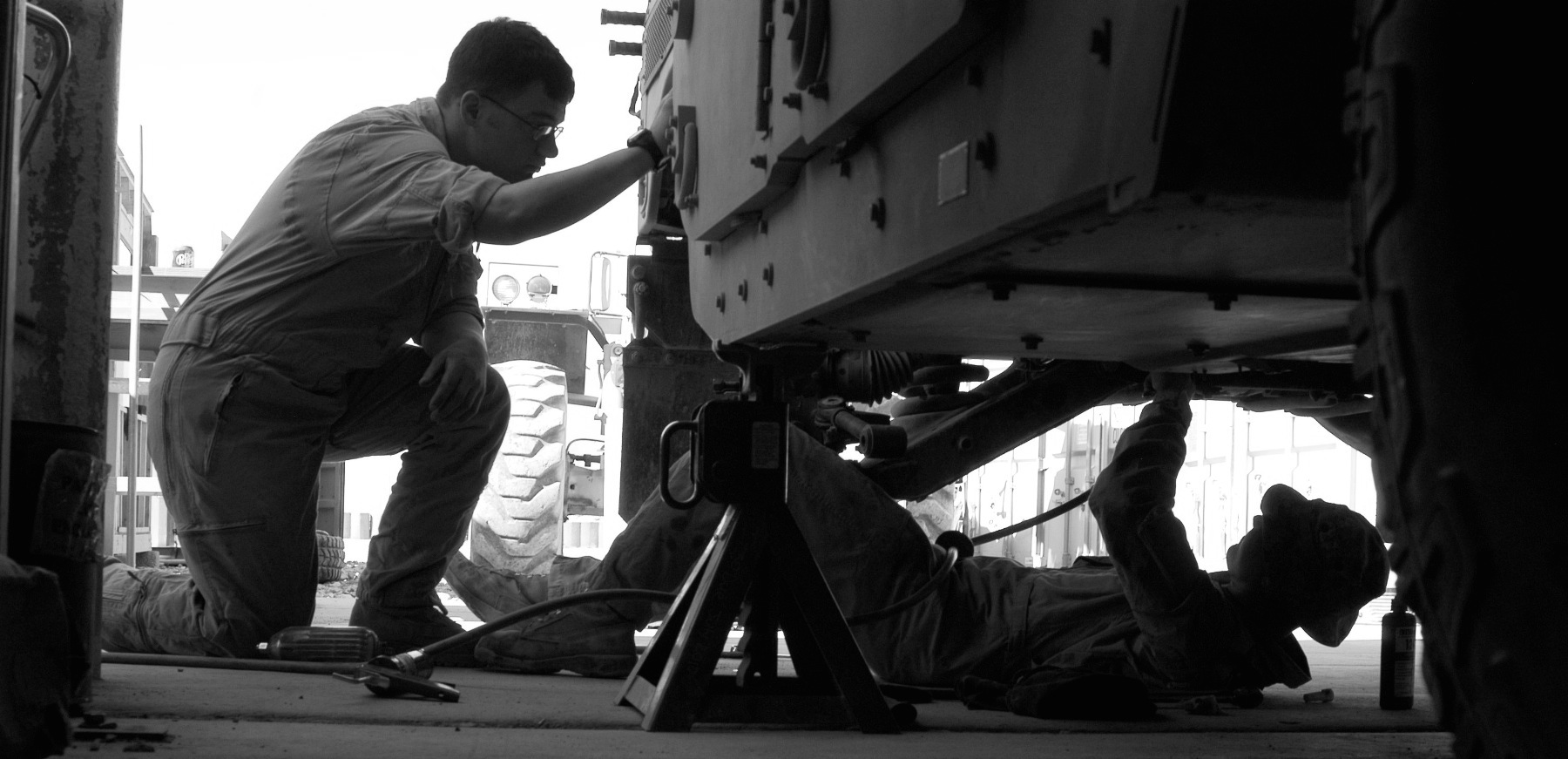 Mechanics work on maintenance and repair of machinery and vehicles, which often involves removing parts for cleaning or replacement. Asbestos was widely used in auto parts, such as brake pads, clutches, and hoodliners, and may be present in older vehicles and machinery [4,5].
Mechanics work on maintenance and repair of machinery and vehicles, which often involves removing parts for cleaning or replacement. Asbestos was widely used in auto parts, such as brake pads, clutches, and hoodliners, and may be present in older vehicles and machinery [4,5].
-
- Industrial, farm and construction machinery mechanics and repairers: 1.52 times the risk
Relative Risk by Industry and Occupation
Figure 1. Risk of asbestosis diagnosis among workers employed in each industry group relative to all others, Occupational Disease Surveillance System (ODSS), 1999-2016
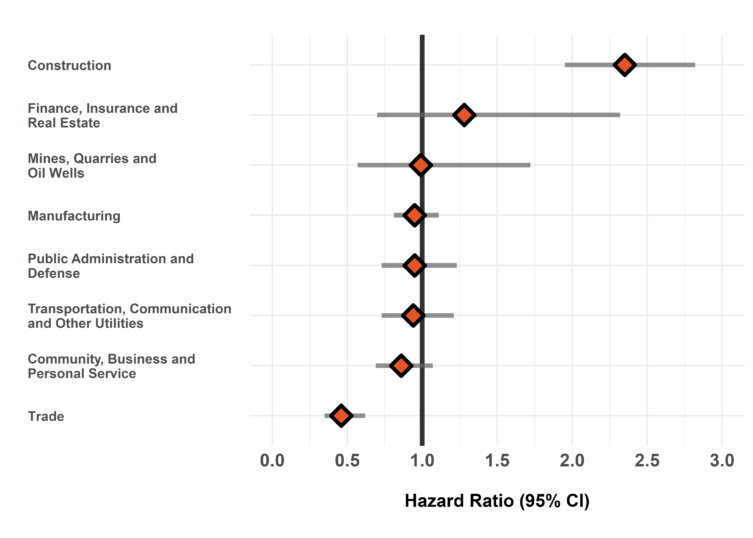
The hazard ratio is an estimate of the average time to diagnosis among workers in each industry/occupation group divided by that in all others during the study period. Hazard ratios above 1.00 indicate a greater risk of disease in a given group compared to all others. Estimates are adjusted for birth year and sex. The width of the 95% Confidence Interval (CI) is based on the number of cases in each group (more cases narrows the interval).
Figure 2. Risk of asbestosis diagnosis among workers employed in each occupation group relative to all others, Occupational Disease Surveillance System (ODSS), 1999-2016
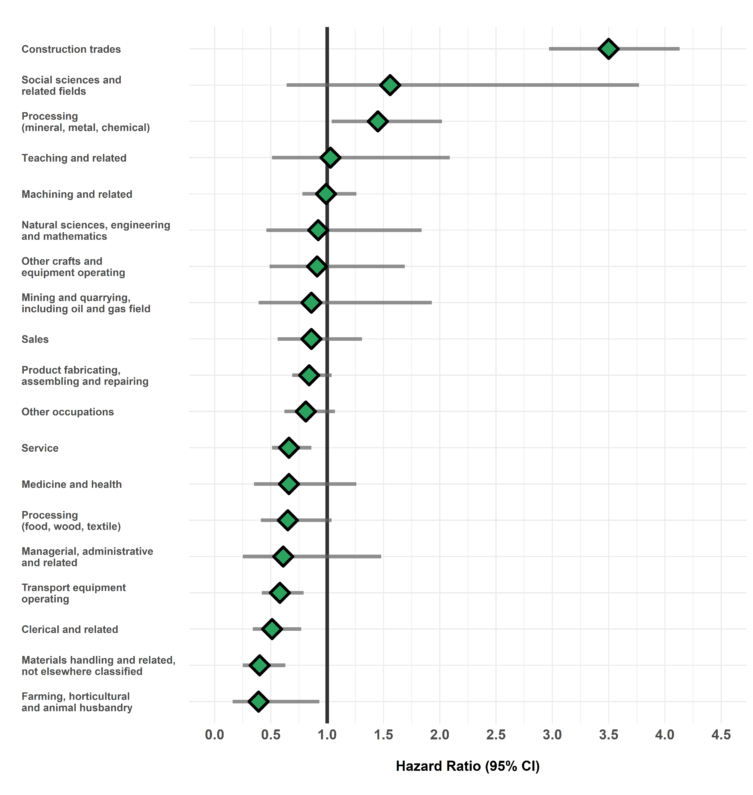
The hazard ratio is an estimate of the average time to diagnosis among workers in each industry/occupation group divided by that in all others during the study period. Hazard ratios above 1.00 indicate a greater risk of disease in a given group compared to all others. Estimates are adjusted for birth year and sex. The width of the 95% Confidence Interval (CI) is based on the number of cases in each group (more cases narrows the interval).
Table of Results
Table 1. Surveillance of Asbestosis: Number of cases, workers employed, and hazard ratios in each industry (SIC)
| SIC Code * | Industry Group | Number of cases | Number of workers employed | Hazard Ratio (95% CI) † |
| 1 | Agriculture | <5 | 27,818 | — |
| 2/3 | Forestry, Fishing and Trapping | 0 | 7,857 | — |
| 4 | Mines, Quarries and Oil Wells | 13 | 18,210 | 0.99 (0.57-1.72) |
| 5 | Manufacturing | 243 | 565,700 | 0.95 (0.81-1.11) |
| 6 | Construction | 153 | 175,617 | 2.35 (1.95-2.82) |
| 7 | Transportation, Communication and Other Utilities | 66 | 165,930 | 0.94 (0.73-1.21) |
| 8 | Trade | 52 | 357,376 | 0.46 (0.35-0.62) |
| 9 | Finance, Insurance and Real Estate | 11 | 19,414 | 1.28 (0.70-2.32) |
| 10 | Community, Business and Personal Service | 98 | 483,986 | 0.86 (0.69-1.07) |
| 11 | Public Administration and Defense | 63 | 157,922 | 0.95 (0.73-1.23) |
| * SIC: Standard Industrial Classification (1970) | ||||
| † Hazard ratio in each group relative to all others | ||||
Table 2. Surveillance of Asbestosis: Number of cases, workers employed, and hazard ratios in each occupation (CCDO) group
| CCDO Code * | Occupation Group | Number of cases | Number of workers employed | Hazard Ratio (95% CI) † |
| 11 | Managerial, administrative and related | 5 | 26,772 | 0.61 (0.25-1.48) |
| 21 | Natural sciences, engineering and mathematics | 8 | 22,785 | 0.92 (0.46-1.84) |
| 23 | Social sciences and related fields | 5 | 24,939 | 1.56 (0.64-3.77) |
| 25 | Religion | 0 | 113 | — |
| 27 | Teaching and related | 8 | 41,692 | 1.03 (0.51-2.09) |
| 31 | Medicine and health | 10 | 108,759 | 0.66 (0.35-1.26) |
| 33 | Artistic, literary, recreational and related | <5 | 12,729 | — |
| 41 | Clerical and related | 23 | 162,132 | 0.51 (0.34-0.77) |
| 51 | Sales | 22 | 123,283 | 0.86 (0.56-1.31) |
| 61 | Service | 62 | 298,287 | 0.66 (0.51-0.86) |
| 71 | Farming, horticultural and animal husbandry | 5 | 40,974 | 0.39 (0.16-0.93) |
| 73 | Fishing, hunting, trapping and related | 0 | 463 | — |
| 75 | Forestry and logging | 0 | 7,730 | — |
| 77 | Mining and quarrying, including oil and gas field | 6 | 10,079 | 0.86 (0.39-1.93) |
| 81 | Processing (mineral, metal, chemical) | 37 | 67,239 | 1.45 (1.04-2.02) |
| 82 | Processing (food, wood, textile) | 18 | 81,535 | 0.65 (0.41-1.04) |
| 83 | Machining and related | 76 | 161,878 | 0.99 (0.78-1.26) |
| 85 | Product fabricating, assembling and repairing | 107 | 276,755 | 0.84 (0.69-1.04) |
| 87 | Construction trades | 230 | 181,331 | 3.50 (2.97-4.13) |
| 91 | Transport equipment operating | 40 | 143,836 | 0.58 (0.42-0.79) |
| 93 | Materials handling and related, not elsewhere classified | 19 | 128,517 | 0.40 (0.25-0.63) |
| 95 | Other crafts and equipment operating | 10 | 23,406 | 0.91 (0.49-1.69) |
| 99 | Other occupations not elsewhere classified | 55 | 180,646 | 0.81 (0.62-1.07) |
| * CCDO: Canadian Classification Dictionary of Occupations (1971) | ||||
| † Hazard ratio in each group relative to all others | ||||
Time Trends
Figure 1. Crude incidence rate of asbestosis among males in the ODSS, 2000-2014 (n=1.76 million)
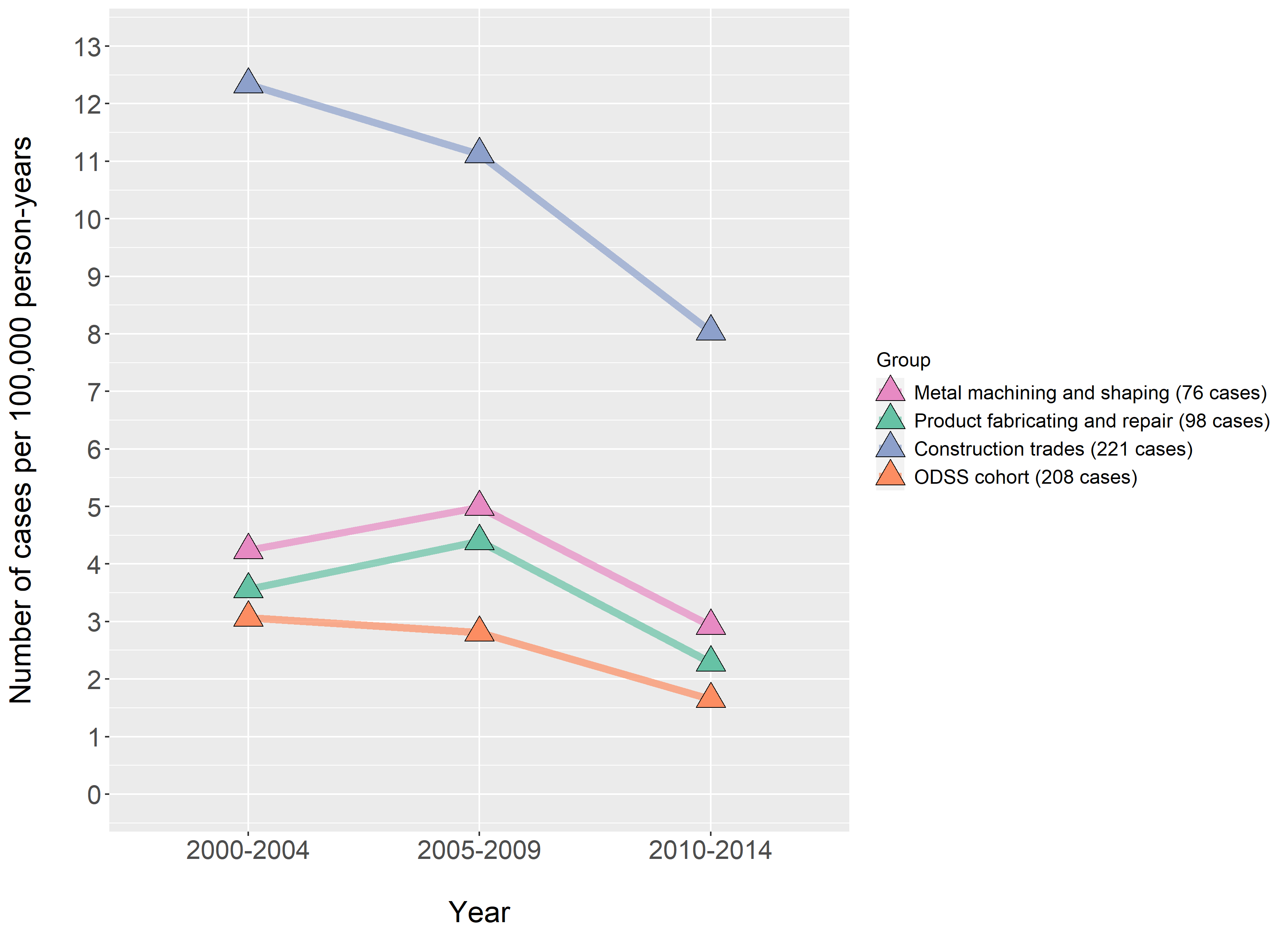
The crude incidence rate is the number of cases of disease diagnosed per person per year of follow-up in the ODSS cohort. The age-standardized incidence rate is the rate we would observe if we removed the influence of aging in the cohort over time. The general population of males in Ontario in 1995 was used as the standard. All rates are expressed per 100,000 persons per year.
Figure 2. Age-standardized incidence rate of asbestosis among males in the ODSS, 2000-2014 (n=1.76 million)
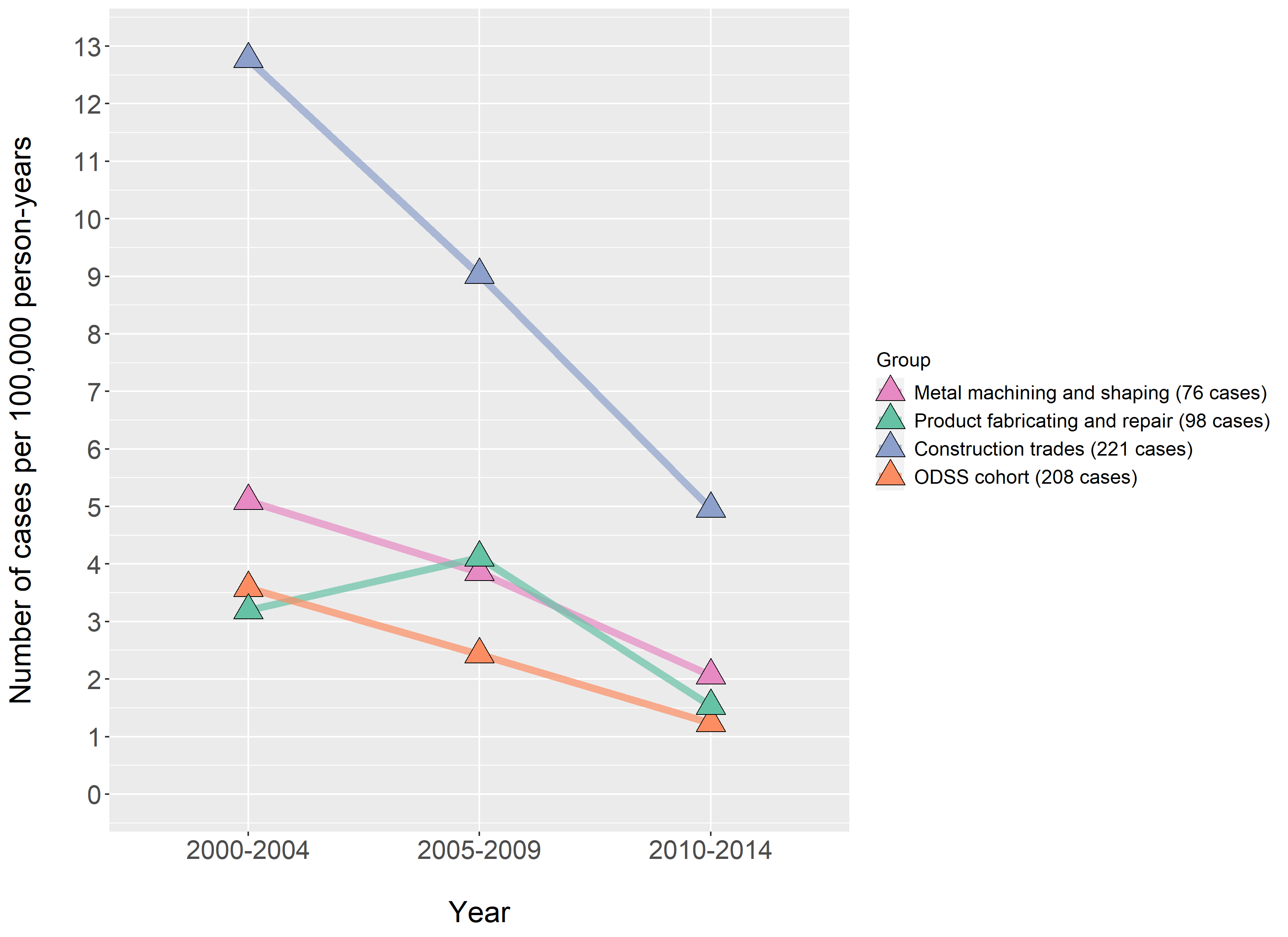
The crude incidence rate is the number of cases of disease diagnosed per person per year of follow-up in the ODSS cohort. The age-standardized incidence rate is the rate we would observe if we removed the influence of aging in the cohort over time. The general population of males in Ontario in 1995 was used as the standard. All rates are expressed per 100,000 persons per year.
Please note that ODSS results shown here may differ from those previously published or presented. This may occur due to changes in case definitions, methodological approaches, and the ongoing nature of the surveillance cohort.
References
- International Agency for Research on Cancer (IARC). Arsenic, metals, fibres, and dusts. IARC Monographs on the Evaluation of Carcinogenic Risks to Humans Vol. 100C (2012).
- Government of Canada. Asbestos (Updated 2020).
- Williams PRD, Phelka AD, Paustenbach DJ. A review of historical exposures to asbestos among skilled craftsmen (1940-2006). J Toxicol Environ Heal – Part B Crit Rev. 2007;10(5):319–77.
- Paustenbach DJ, Finley BL, Lu ET, Brorby GP, Sheehan PJ. Environmental and occupational health hazards associated with the presence of asbestos in brake linings and pads (1900 to present): A “state-of-the-art” review. J Toxicol Environ Heal – Part B Crit Rev. 2004;7(1):25–80.
- Jiang GCT, Madl AK, Ingmundson KJ, Murbach DM, Fehling KA, Paustenbach DJ, et al. A study of airborne chrysotile concentrations associated with handling, unpacking, and repacking boxes of automobile clutch discs. Regul Toxicol Pharmacol. 2008;51(1):87–97.
